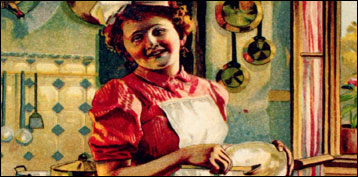



More
German cuisine
tips and insights
Food tips you can trust

Defining
German cuisine
 The term "German cuisine"
The term "German cuisine"
is difficult to define precisely
because ...
 Germany is more of
a land of regional cuisines than a unified national cuisine.
Germany is more of
a land of regional cuisines than a unified national cuisine.
 Food preferences
among many Germans are changing:
Food preferences
among many Germans are changing:
 An increasing
number of Germans are preferring lighter over heavier traditional fare.
An increasing
number of Germans are preferring lighter over heavier traditional fare.
 More Germans
take vacations abroad. They bring home foreign culinary concepts and
adopt them into their cooking and eating styles.
More Germans
take vacations abroad. They bring home foreign culinary concepts and
adopt them into their cooking and eating styles.
 The influx of
Turkish and other foreign workers has accelerated the introduction of
new flavors and menu items.
The influx of
Turkish and other foreign workers has accelerated the introduction of
new flavors and menu items.
Still, there remains today a German cuisine with a distinct, time-honored character. And that character is defined largely by Germany's regional cuisines.
Foreign culinary
influences on
German cuisine
 Crossroads location
Crossroads location
Germany lies within the well traveled crossroads of Europe and, as a result, German cuisine has been greatly influenced by its neighbors.
For instance, in the northeast, one detects the widespread use of sour cream, characteristic of the cooking of adjacent Poland. Other influences have come from other directions, including Scandinavian, Dutch, French, Austrian, and Czechoslovakian.
 However...
However...
This in no way implies that the regions of Germany have not developed distinctive cooking styles. And because Germany was not unified as a nation until 1871, the regional cuisines are especially significant and well entrenched.
Popular German
cooking ingredients
 Meat and seafood
Meat and seafood
Pork is the favorite, though beef frequently appears on household tables.
Chicken and duck are popular, but it is the goose (traditionally cooked and served with apples and prunes) that captures the fancy of most German diners.
The country abounds with forests and, consequently, game like venison, wild boar, hare, pheasant, and river trout contribute to the national fine dining tradition.
Northern Germany has lengthy Baltic and North Sea coastlines. The cool waters yield abundant and flavorful seafood.
 Vegetables, grains,
Vegetables, grains,
and flavoring agents
The popular potato adds to Germany's high carbohydrate count, appearing either boiled, or shredded for pancakes or dumplings. Interestingly, these tubers are a relatively recent (mid 18th century) addition to the historical German larder.
Hearty vegetables such as red and green cabbage (fresh or fermented into sauerkraut), carrots, radishes, and turnips are also popular, as is the delicate white asparagus for which Germany is famous.
Germany has some of the best bakers in the world. They transform cereal grains into splendid cakes, pastries, and breads.
For flavoring agents, herbs such as dill, chervil, basil, and thyme are used; so are caraway seeds, juniper berries, and prepared mustard. A sweet-sour flavor, obtained with vinegar and fresh or dried fruit, is highly prized.
Learn more
about German food
Click blue links
to open my other
German pages
Famous German dishes
Main dishes - A to K
Main dishes - L to Z
Sausages
Side dishes & soup
Cheese, hors d'oeuvres & sauce
Sweets & street food
Famous German beverages
Beer
Wine
Beverages - Other
My other German food pages
Menu translator
Regional cuisines
Cooking ingredients
More tips & insights
Travel wonders
Top 10 wonders of Germany


Rankings
Peasant recipes
World wonders
Also read
Site map
About me and my credentials
About my website
Reader testimonials
Email me your opinion



